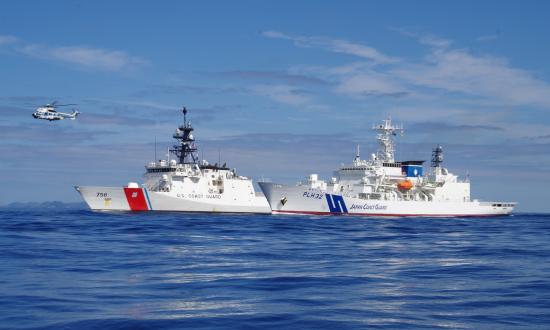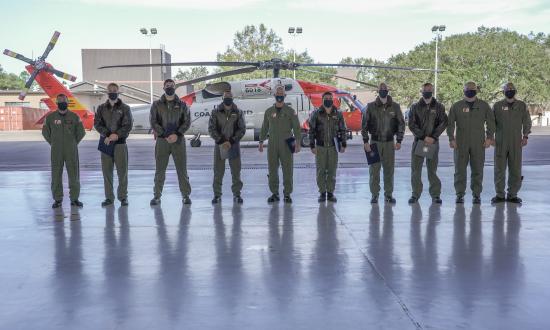In December 2020, the chiefs the Coast Guard, Navy, and Marine Corps signed Advantage at Sea, the triservice maritime strategy that challenged the naval services to integrate, partner, and modernize to prevail against the rising maritime threats posed by Russia and China. The strategy issued a stark warning: “We must act with urgency to integrate and modernize our forces as we prepare for the challenges ahead. The boldness of our actions must match the magnitude of our moment. The security of our Nation depends on our ability to maintain advantage at sea.”1
At present, the Coast Guard cannot fully integrate, as its helicopters are missing tactical data links (TDLs). TDLs can share information among helicopters, the cutters they support, and U.S. and NATO navy assets with whom the Coast Guard integrates. They are force multipliers, providing a joint maritime force accurate and timely maritime domain awareness information. Those that leverage this information are more informed and capable, which for the Coast Guard means enhanced performance across many of its core missions, such as defense readiness, maritime law enforcement, and search and rescue.
TDLs in the Coast Guard
TDLs have been in use since the 1950s to share asset location and targeting information. At the time, Link 11 was designed to share information among small numbers of units. Link 16, now the preeminent TDL, was implemented in the 1980s with better security, jam resistance, throughput, and capacity. In the late 1990s and early 2000s, Link 22 was designed to resolve the deficiencies of Link 11 and complement Link 16.2 U.S. and NATO navy assets, along with Coast Guard national security cutters, use Link 11 and Link 16 to share information gathered from sensing equipment, self-reporting, and visual identification.3 This affords joint partners a real-time common operating picture (COP) of assets and threats across the globe. In addition, Link 16 capability was recently added to the Coast Guard’s MH-65D Dolphin helicopters performing the rotary-wing air intercept (RWAI) mission.4 Link 16 integration during the RWAI mission allows MH-65D pilots a real-time, visual display of target information from the North American Aerospace Defense Command as they proceed to intercept aerial threats.
Defense Readiness
The Coast Guard should seek this capability beyond its RWAI mission. As joint deployments increase and next-generation cutters come online, Coast Guard helicopters need to be able to fold into the operational picture seamlessly. Contacts detected by MH-65 and MH-60 helicopters must be immediately shareable among Coast Guard, Department of Defense (DoD), and NATO assets to “be prepared to operate across a full spectrum of conflict, across multiple domains at once.”5 In their current state, Coast Guard helicopters use the radio to report contacts identified visually, by radar, or with electro-optical sensors. While effective, a voice report to share a contact’s fix and track is labor intensive and latent, diverting an aircrew’s focus away from mission execution without providing a real-time operational picture to the cutter. With TDLs, helicopters become an extension of cutters’ sensing capability and would allow the Coast Guard and joint partners to “sense, decide, and act more quickly and effectively than our adversaries.”6
Similarly, as the service reinvigorates its icebreaking fleet and prepares for an era of newly opened and contested Arctic waters, Coast Guard helicopters must be equally ready. As then-Commandant of the Coast Guard Admiral Karl Shultz stated in his 2021 State of the Coast Guard Address, “Our first MH-60T Jayhawk outfitted with blade-fold/tail-fold capability will enable deployment aboard national security cutters, and our future polar security and offshore patrol cutters.”7 The MH-60T will bring immense range to the cutter fleet, especially in contested Arctic regions. However, it has limited capability to prosecute search-and-rescue, law-enforcement, and defense-readiness missions without TDLs.
Linking with DoD and NATO nations does more than expand maritime domain awareness—it provides a new avenue to engage with NATO allies. As stated in Advantage at Sea, “The Coast Guard is expanding its global engagements and capacity-building efforts in key vulnerable regions . . . developing new operational concepts and redesigning [its] forces to provide the capability and capacity to execute them.”8 The Coast Guard’s role as both a military service and law enforcement agency affords it a unique position between diplomacy and lethality. In spring 2021, the national security cutter USCGC Hamilton (WMSL-753) completed underway flight operations in the Mediterranean and Black Seas alongside NATO allies and partners. A training scenario using Coast Guard helicopters beyond the cutter’s sensor range, while linking data with NATO allies in the region, would allow cutters to extend the range of their engagements. Through a shared COP built on TDL information-sharing, the Coast Guard and NATO allies can increase mission effectiveness in disputed maritime regions.
Maritime Law Enforcement
In addition to aligning the Coast Guard with the other U.S. naval services, fitting TDLs to legacy Coast Guard helicopters will help the service maintain its leadership role in the maritime environment. Coast Guard helicopters are the drug-interdiction tip of the spear. Helicopter Interdiction Tactical Squadron Jacksonville aircraft deploy on Coast Guard and allied vessels in the Caribbean and eastern Pacific to interdict drug shipments and dismantle transnational criminal organizations. With no real-time TDL, these helicopters execute missions based on GPS positions and vectors, often passed to them by joint maritime patrol assets, embarked unmanned systems, or the cutter itself. The helicopter mission commander pursues the target of interest and manages the on-scene execution of the case, ultimately vectoring cutter small boats to conduct a boarding.
The mission commander, however, is often blind to the real-time location of the target and boarding team until both are visually in sight. Providing these movements on a COP linked among helicopter, cutter, and maritime patrol asset would greatly reduce aircrew workload and enable the interdiction network to be more effective. Furthermore, if the target is beyond the cutter’s sensor range, a helicopter with TDL would allow the cutter to “see” the case progress as if it were much closer, providing operational commanders greater situational awareness and control.
Search and Rescue
TDL advantages extend beyond joint service drug interdiction. Search and rescue, the Coast Guard’s most well-known mission, can be significantly improved with helicopter TDL integration, and even more so with integration into its Rescue 21 system (a coastal network of radio towers designed to approximate VHF transmission origin).
Currently, Coast Guard aircraft launch on search-and-rescue cases with search patterns and GPS positions passed by coordination centers via phone and radio. For example, when Coast Guard Sector New Orleans responds to a medical evacuation request 250 nautical miles offshore, an MH-60T from Air Station New Orleans and an HC-144 Ocean Sentry aircraft (a faster plane with more endurance) from Aviation Training Center Mobile, Alabama, launch to respond. The helicopter flies toward the medical evacuation position and the plane flies ahead to support, in part by confirming positions and acting as a communications relay. TDLs could improve this operation. As part of a joint network, Sector New Orleans could link with partner aircraft and ships in the vicinity to build a COP before launching aircraft. Once in route, the HC-144 could use its Minotaur Mission System to transmit surveillance information during flight, giving the MH-60T crew more accurate information sooner while the sector watches the case unfold.9
Furthermore, integrating TDL into Rescue 21 could leverage nearby DoD assets to monitor for Coast Guard missions. Using a TDL via Rescue 21, the Coast Guard could share data with DoD assets on offshore sorties. By forwarding the data or syncing with a common TDL, DoD assets could help build a COP for Coast Guard coordination centers. Couple this with a requirement that all Coast Guard aircraft use TDLs, and the coordination centers could now see any contact track, anywhere, provided it is seen by a Coast Guard or DoD asset.
Natural Disasters
Using TDLs to provide helicopters with search-and-rescue coordinates would also alleviate congested radios during natural disasters. In 2016, the Coast Guard responded to devastating flooding in Baton Rouge, Louisiana. It was just one of the service’s major flooding responses since Hurricane Katrina in 2005 and incorporated assets from multiple units (New Orleans and Mobile) and joint services (National Guard). When Hurricane Harvey hit Houston, Texas, a year later, the Coast Guard used cloud-based spreadsheet tools to track and assign cases with the lessons learned from Baton Rouge.
Over the ensuing year, the service integrated a commercial digital map application to track the position and progress of ongoing distress cases during the 2018 hurricane season. While these developments aided case management in mass rescue events, they did not solve radio transmission difficulties. During Hurricane Harvey and other natural disasters in the past five years, radio space for task coordination was congested. Aircraft were constantly completing assignments, passing status updates, and requesting new tasking. With so many aircraft responding to people in distress in a small operating area and with limited radio space, information passed slowly. TDLs would improve this.
Coordination centers could assign target information to helicopters via TDL without the need for verbal transmission, freeing up radio space. The capability would further benefit a response in two ways. First, during disasters like Hurricane Harvey—when helicopters could hardly see street lamps, let alone each other—it offers additional redundancy for airspace deconfliction. Second, it enables safe and effective joint operations by creating one COP for all responding services and TDL-capable assets.
TDL integration for Coast Guard aircraft—and ideally coordination centers and Rescue 21—could be a force multiplier for Coast Guard assets and across the U.S. and NATO naval services. TDL integration is key to the Coast Guard’s rotary-wing future, not only making helicopters more capable assets for legacy missions, but also enhancing the service’s maritime domain awareness.
1. U.S. Navy, U.S. Marine Corps, and U.S. Coast Guard, Advantage at Sea: Prevailing with Integrated All-Domain Naval Power (Washington, DC: December 2020).
2. Northrop Grumman, “Understanding Voice and Data Link Networking: Northrop Grumman’s Guide to Secure Tactical Data Links,” December 2014.
3. Northrop Grumman, “Understanding Voice and Data Link Networking.”
4. ADM Karl L. Schultz, USCG, State of the Coast Guard Address 2021, 11 March 2021.
5. National Security Strategy of the United States of America (Washington, DC: December 2017).
6. U.S. Navy, U.S. Marine Corps, and U.S. Coast Guard, Advantage at Sea.
7. Schultz, State of the Coast Guard Address 2021.
8. U.S. Navy, U.S. Marine Corps, and U.S. Coast Guard, Advantage at Sea.
9. U.S. Coast Guard Acquisition Directorate, “Mission Minotaur System.”







